- Home
- SFI soils payments given a boost for 2023
SFI soils payments given a boost for 2023
In August, farmers will be able to apply for the Sustainable Farming Incentive (SFI) 2023. We show the advantages of this latest version of the scheme.
SFI 2023 actions for soils were published by Defra in late June. We’ve compared them with the SFI 2022 scheme.
Main findings
SFI 2023 will have more flexibility. Farmers as can choose actions rather than having to carry out a list of defined activities under various standards. Farmers who are already taking part in the SFI scheme will be able to transition to the 2023 offer.
Farmers will receive higher payments. Published rates for the soils actions under SFI 2023 are considerably larger than their SFI 2022 counterparts. The net payments, which take into account the costs involved in carrying out the actions, are also higher for 2023.
The improvement in a farm’s net profit levels, as a result of the increased net payment is only a percent or two at most. This is because the reduction in Direct Payments far outweighs the additional income from SFI payments.
To make a more substantial improvement in the overall net profit, farmers will need to ‘stack’ multiple compatible actions together. We will be following up on this analysis by looking at stacking various actions together in the coming weeks.
How SFI has evolved
SFI 2022 had three standards available, including two soil standards:
- Arable and horticultural soils
- Improved grassland soils
Farmers could enter either the introductory or intermediate level of these standards, each of which had a set of actions to complete. In our 2022 analysis of the SFI we looked at these standards in detail, including their economic impact on farm profit margins.
SFI in 2023: six standards were added in January, giving more flexibility for farmers to pick from individual actions rather than signing up to standards where all actions must be completed to qualify for payment. The full detail was then published in late June.
From August, farmers will be able to apply for SFI 2023 and can choose from three individual actions which are designed to improve soils:
- SAM1: Assess soil, produce a management plan and test soil organic matter
- SAM2: Multi-species winter cover crops
- SAM3: Herbal leys
There are fewer soil actions than in 2022: SAM1 and SAM2 cover three of the five actions that were required under the intermediate level of the 2022 arable and horticultural soils standard. SAM1 and SAM3 cover three out of the four requirements for the 2022 improved grassland soils standard.
Comparison of payments between the 2022 and 2023 SFI
A comparison of the payment rates is shown in Table 1.
Table 1. Payment rates for SFI 2022 soil standards and SFI 2023 soil actions
| Standard/Action | Payment rate, £/ha |
|---|---|
|
2022 Arable and horticultural soils (Introductory) |
22 |
|
2022 Arable and horticultural soils (Intermediate) |
40 |
|
2022 Improved grassland soils (Introductory) |
28 |
|
2022 Improved grassland soils (Intermediate) |
58 |
|
2023 SAM1 |
5.80 plus £95 per agreement |
|
2023 SAM2 |
129 |
|
2023 SAM3 |
382 |
Source: Defra
The payment rates for the 2023 actions are a considerable improvement on those previously set for the SFI 2022 soils standards, but there are costs associated with these actions.
As the 2023 actions are similar to those in the 2022 soil standards, the associated costs will be comparable. So, how much could farmers receive per hectare for carrying out these actions after costs have been accounted for (i.e. the net payment)?
In our previous analysis of the SFI 2022 soils standards, we used AHDB virtual farms to calculate the net payments farmers could receive and the impact this would have on the farm’s overall profit. These virtual farms were created as middle 50% performing businesses whose physical performance is comparable to national and regional averages.
We consider the implications for arable soils, and below that for grassland soils.
What does this mean for arable soils?
Better net payments
Figure 1 shows a marked improvement of the net payment rate for SFI 2023 compared with SFI 2022, with payment for multi-species winter cover crops being the main driver behind the increase.
Figure 1. Comparison of net payments for the SFI 2022 arable and horticultural soils standard (intermediate level) with SFI 2023 soil actions, SAM1 and SAM2 (455 ha arable farm)
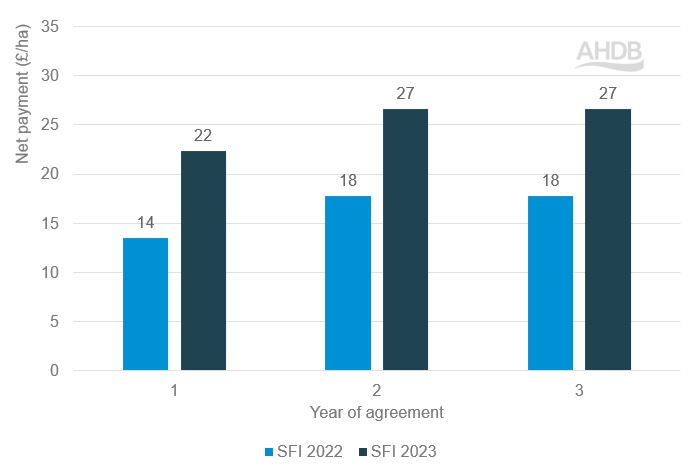
Source: AHDB
Increased net profits
However, as discussed in our previous analysis, the net payment is only part of the story – what impact does this have on the overall profit level of the farm business?
Figure 2 shows that if the 455 ha arable farm takes part in SFI 2023, by just doing the SAM1 and SAM2 actions the net profit (total revenue minus total costs) of the farm increases by up to 1.8% in Year 3 of the scheme.
Figure 2. Change in net profit of 455 ha* arable farm by taking part in SFI 2022 arable and horticultural soils standard (intermediate level) and SFI 2023 SAM1 and SAM2 soil actions
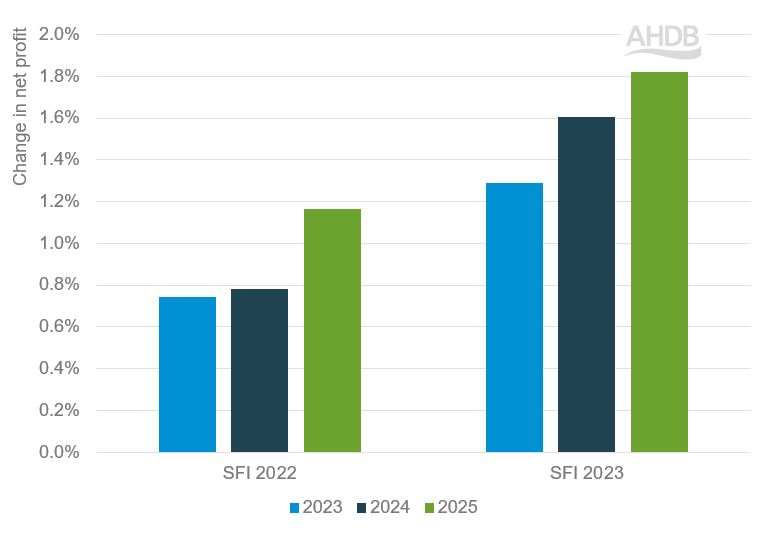
*107 ha of farm entered into scheme and land entered into SAM2 is 20% of 107 ha (21.4 ha)
Source: AHDB
Although there is an improvement in the net profit of the farm by taking part in SFI 2023 compared with not taking part at all, in overall percentage terms it is relatively small compared with the percentage increase in the net payment value.
The other issue to consider, which was highlighted in the 2022 SFI analysis, is whether any productive land will need to be taken out of production in order to grow the multi-species cover crop required in SAM2. In the case of the AHDB 455 ha arable farm, the cover crop could easily be accommodated in the existing rotation, without taking land out of production. If this was not possible, then the effect on the net profit of the farm business would be detrimental, as shown in Figure 3.
Figure 3. Change in net profit of 455 ha* arable farm by taking part in SFI 2022 arable and horticultural soils standard (intermediate level) and SFI 2023 SAM1 and SAM2 soil actions, if land is taken out of production
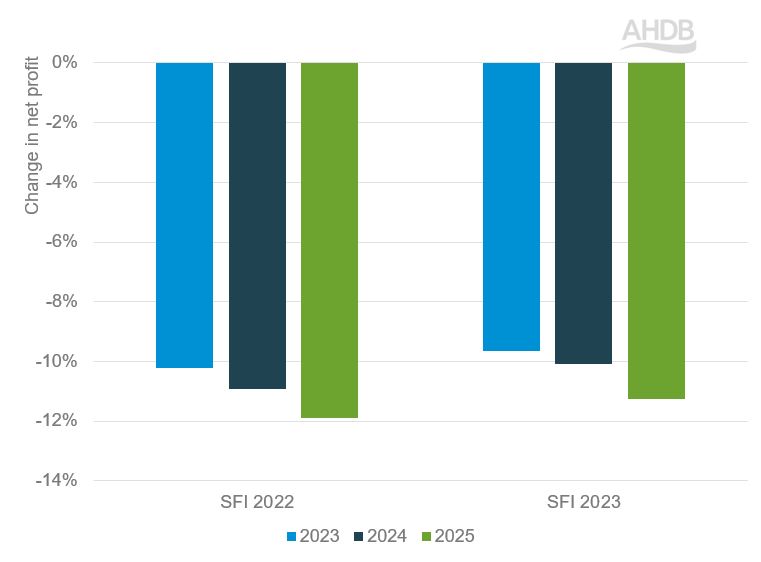
*107 ha of farm entered into scheme and land entered into SAM2 is 20% of 107 ha (21.4 ha)
Source: AHDB
Due to the higher net payment available from the SFI 2023 actions, the decline in net profit is not as great compared with the case for the intermediate level of the 2022 arable and horticultural soils standard, but the loss is still considerable. This highlights how, in the short term, this action is only profitable where productive land does not need to be compromised. In the long term, it could be argued that introducing a cover crop into the rotation could increase productivity of the soil and so boost yields and revenue further down the years.
In the 2023 analysis, we used the 455 ha arable virtual farm (one of three AHDB arable virtual farms), located in the East of England. The cropped area of the farm is 450 ha as woodland and other buildings/roads etc account for 5 ha. The farm also has 22 ha entered into the Countryside Stewardship scheme, which leaves 428 ha available for the SFI.
Both the 2022 and 2023 analysis are based on a quarter (107 ha) of the available area being entered into the SFI. We calculated the costs associated with carrying out the 2023 soils actions, SAM1 and SAM2, then subtracted the cost per hectare from the payment per hectare to arrive at the net payment per hectare. For SAM2, the multi-species cover crop requirement is grown on 20% of the 107 ha entered. This matches the criteria in the intermediate level of the SFI 2022 arable and horticultural soils standard where a multi-species winter cover crop had to be grown on 20% of the land entered. These net payments are compared with the net payments that would be available under the intermediate level of the 2022 arable and horticultural soils standard in Figure 1.
The net payment has been calculated for the three years of the SFI agreement as there are some actions which only need to be done once (e.g. soil organic matter testing), while others are annual requirements (e.g. multi-species winter cover crops).
Please note that the net payments for SFI 2022 in Figure 1 were calculated using updated prices for soil tests and seed and so differ slightly from the net payments published in the 2022 report. At the time of writing, the market price of the multi-species cover crop seed used was £58.6/ha.
We entered these net payments into the overall accounts of the farm. As we are just looking at the impact of taking part in the SFI, every other variable was kept constant over the three-year period of the scheme, such as prices and yields. The gradual reduction in Direct Payments, however, was factored in.
What does this mean for grassland soils?
Better net payments
The increase in net payments between SFI 2022 and SFI 2023 is nine-fold in year 1 and seven-fold in years 2 and 3.
Figure 4. Comparison of net payments for the SFI 2022 improved grassland soils standard (intermediate level) with SFI 2023 soil actions, SAM1 and SAM3 (220 ha mixed farm)
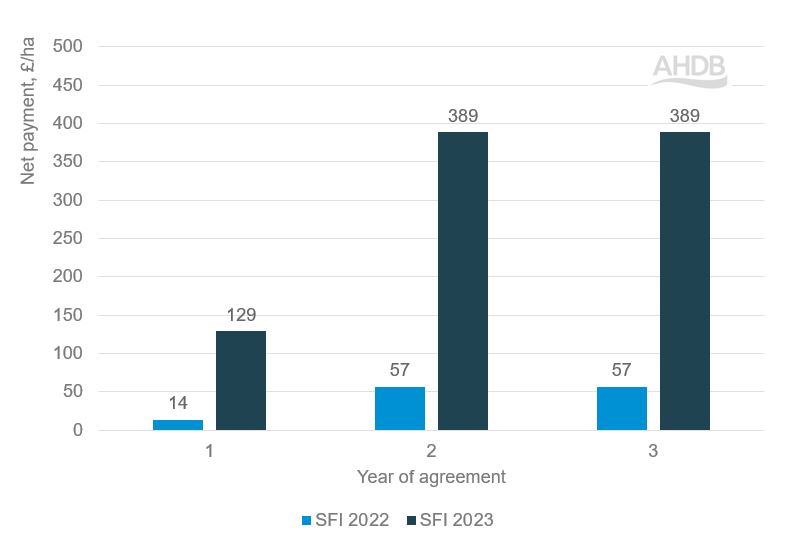
Source: AHDB
The net payment in years 2 and 3 are considerably higher than that in year 1 because once the herbal ley requirement in SAM3 is established in year 1, it is expected to last for the remainder of agreement and only requires some maintenance. Soil organic matter testing is also only required (if not carried out within the previous five years) in year 1.
While this is an impressive improvement, how does this affect the overall net profit of the farm business?
Increased net profits
Figure 5 shows that if the 220 ha mixed farm takes part in SFI 2023, by doing the SAM1 and SAM3 actions, the net profit (total revenue minus total costs) of the farm increases by up to 4% and is similar to the increase in net profit seen for the 2022 improved grassland soils standard.
Figure 5. Change in net profit of 220 ha* mixed farm by taking part in SFI 2022 improved grassland soils standard (intermediate level) and SFI 2023 SAM1 and SAM3 soil actions
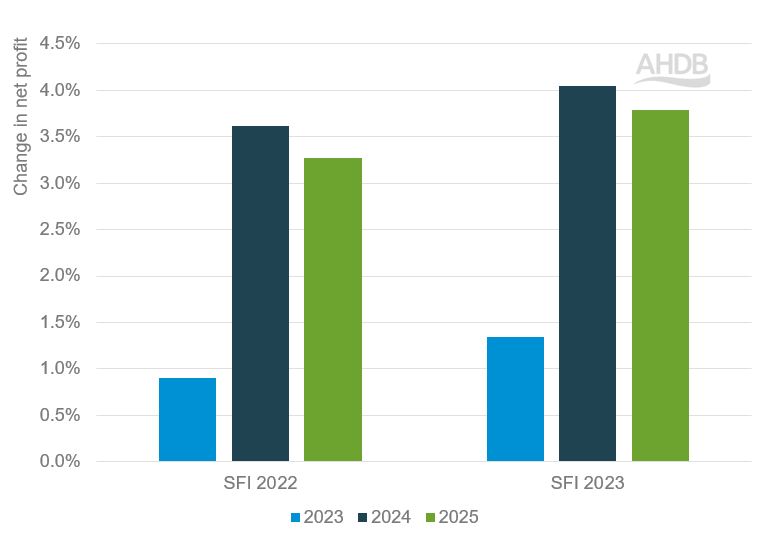
*55 ha of farm entered into scheme and land entered into SAM3 is 15% of 55 ha (8.25ha)
Source: AHDB
We analysed the impact of the SFI 2022 improved grassland soils standard on farm businesses in our report published in 2022. In this analysis, we compare the SFI 2023 soils actions SAM1 and SAM3 with the intermediate level of the SFI 2022 improved grassland soils standard using the 220 ha mixed AHDB virtual farm in Yorkshire and the Humber. This analysis is based on 25% of the farm (55 ha) being entered into the SFI (as in the original 2022 analysis).
As with the analysis of arable soil actions, we’ve calculated the costs associated with carrying out the 2023 soils actions, SAM1 and SAM3, then subtracted the cost per hectare from the payment per hectare to arrive at the net payment per hectare. These net payments are compared with the net payments that would be available under the intermediate level of the 2022 improved grassland soils standard in Figure 4.
Please note that the net payments for SFI 2022 in Figure 4 have been calculated using updated prices for soil tests and seed and so differ slightly from the net payments published in the 2022 report. At the time of writing, the market price of the herbal ley seed used was £204.75/ha.
Conclusions
Our analysis shows that things are moving in the right direction in terms of payments for farmers. One of the key points from our 2022 analysis was that the financial incentive for farmers needed to be greater in order for them to operate profitable a business while taking part in the scheme.
Different farms will be impacted in different ways, based on the existing set-up of the farm, practices that are already being carried out, and the scope to make changes while incurring little extra cost.
So, it’s worth making a plan and investigating which actions work for you and your farm going forward.
Useful links
Our 2022 report: Assessing the impact of the Sustainable Farming Incentive on farm businesses
SFI actions for soils on GOV.UK, including what land is eligible for each action, and what you need to do to get paid.
Discover practical information on soil management in our GREATsoils section.

